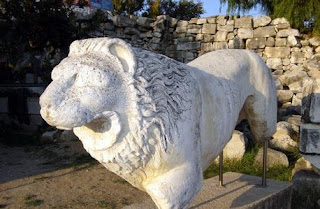Apollo
Temple of Apollo

The city's ruins include a harbor monument adorned with carvings of marine life on one side and a half-man, half-fish triton on the other. Also uncovered are the remarkably well-preserved Baths of Faustina, erected by the wife of Marcus Aurelius, which include a headless but otherwise exquisite reclining statue. Ancient Didyma was not a city, but rather the home of the God Apollo. Only priests were allowed entry here to consult the oracle in the great Temple of Apollo. The site served as a divine sanctuary at least as early as the 10th Century B.C Priestesses of Delphic origin fasted here for three days, then inhaled sulfur fumes until they entered a supposed state of divine inspiration. Their ramblings were then translated by priests into prophecies. The site continued to issue predictions via pries throughout several centuries. In 300 B.C construction began on the Temple of Apollo and continued for the next 500 years. Of the temple's original 120 columns 103 have been set up again. Some remain unadorned, evidence that the temple was never completed. Didyma and other oracles eventually fell victim to Christianity's scorn for pagan prophecies. The final assault at Didyma was the erection of a Christian chapel in the holiest part of the Temple of Apollo.
Sacred Road
The temple has an elaborate bust of Medusa.A sacred road, used for religious processions, leading to the temple was once lined with statues, but Sir Charles Newton sent these to the British Museum in 1858.
Sacred Road
The temple has an elaborate bust of Medusa.
A sacred road, used for religious processions, leading to the temple was once lined with statues, but Sir Charles Newton sent these to the British Museum in 1858.







